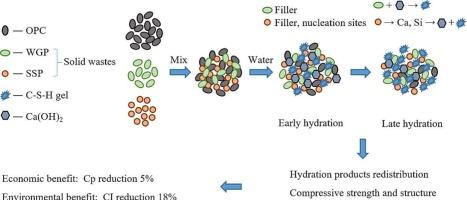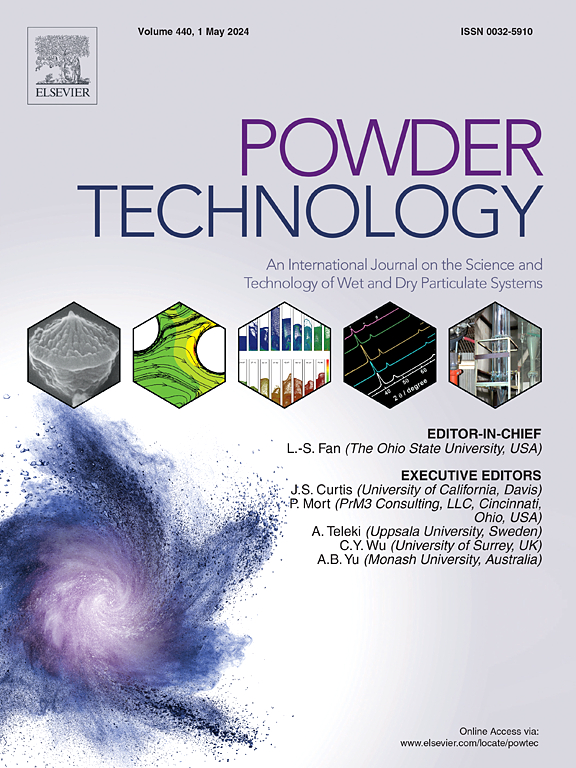废玻璃和钢渣对水泥基材料力学性能和微观结构的协同效应
IF 4.5
2区 工程技术
Q2 ENGINEERING, CHEMICAL
引用次数: 0
摘要
水泥生产对二氧化碳足迹的贡献很大,在这一过程中对固体废物的利用不仅促进了资源节约,而且提高了所得产品的性能。研究了废玻璃粉(WGP)和钢渣粉(SSP)对水泥基材料力学性能和微观结构的协同作用。研究结果表明,当WGP或SSP单独替代普通硅酸盐水泥(OPC)时,替代水平在0 ~ 45%之间,抗压强度显著降低。在早期水化阶段(3-28 d), WGP组的还原率为30% - 50%,SSP组的还原率为10% - 50%。然而,到90d时,还原率不那么明显。在后期水化过程中,WGP的火山灰反应降低了Ca(OH)2的含量,导致水化产物的重新分配,而SSP可以被活化形成额外的C-S-H凝胶和Ca(OH)2。WGP和SSP的联合使用在早期对OPC有加速作用,SSP的水化产生Ca(OH)2,促进了WGP水化后期的火山灰反应。此外,WGP和SSP的协同效应可以带来更大的经济和环境优势。本文章由计算机程序翻译,如有差异,请以英文原文为准。

Synergistic effect of waste glass and steel slag on mechanical property and microstructure of cement-based materials
Cement production significantly contributes to CO2 footprint and the utilization of solid wastes in this process not only promotes resource conservation but also enhances the properties of the resulting product. The synergistic effect of waste glass powder (WGP) and steel slag powder (SSP) on the mechanical properties and microstructure of cement-based materials has been investigated. The findings indicate that when WGP or SSP is used to replace ordinary Portland cement (OPC) individually, with replacement levels ranging from 0 to 45 %, the compressive strength decreases considerably. In WGP group the reduction rate varies from 30 % to 50 % and in SSP group it ranges from 10 % to 50 % during the early hydration stages (3-28 d). However, by 90d the reduction is less notably. During later hydration, the pozzolanic reaction of WGP reduces the Ca(OH)2 content and leading to a redistribution of hydration products, while SSP can be activated to form additional C-S-H gel and Ca(OH)2. The combined use of WGP and SSP demonstrates an acceleration effect on OPC at early stages, and the hydration of SSP generates Ca(OH)2 to promote the pozzolanic reaction of WGP during later hydration. Furthermore, the synergistic effect of WGP and SSP can deliver enhanced economic and environmental advantages.
求助全文
通过发布文献求助,成功后即可免费获取论文全文。
去求助
来源期刊

Powder Technology
工程技术-工程:化工
CiteScore
9.90
自引率
15.40%
发文量
1047
审稿时长
46 days
期刊介绍:
Powder Technology is an International Journal on the Science and Technology of Wet and Dry Particulate Systems. Powder Technology publishes papers on all aspects of the formation of particles and their characterisation and on the study of systems containing particulate solids. No limitation is imposed on the size of the particles, which may range from nanometre scale, as in pigments or aerosols, to that of mined or quarried materials. The following list of topics is not intended to be comprehensive, but rather to indicate typical subjects which fall within the scope of the journal's interests:
Formation and synthesis of particles by precipitation and other methods.
Modification of particles by agglomeration, coating, comminution and attrition.
Characterisation of the size, shape, surface area, pore structure and strength of particles and agglomerates (including the origins and effects of inter particle forces).
Packing, failure, flow and permeability of assemblies of particles.
Particle-particle interactions and suspension rheology.
Handling and processing operations such as slurry flow, fluidization, pneumatic conveying.
Interactions between particles and their environment, including delivery of particulate products to the body.
Applications of particle technology in production of pharmaceuticals, chemicals, foods, pigments, structural, and functional materials and in environmental and energy related matters.
For materials-oriented contributions we are looking for articles revealing the effect of particle/powder characteristics (size, morphology and composition, in that order) on material performance or functionality and, ideally, comparison to any industrial standard.
 求助内容:
求助内容: 应助结果提醒方式:
应助结果提醒方式:


